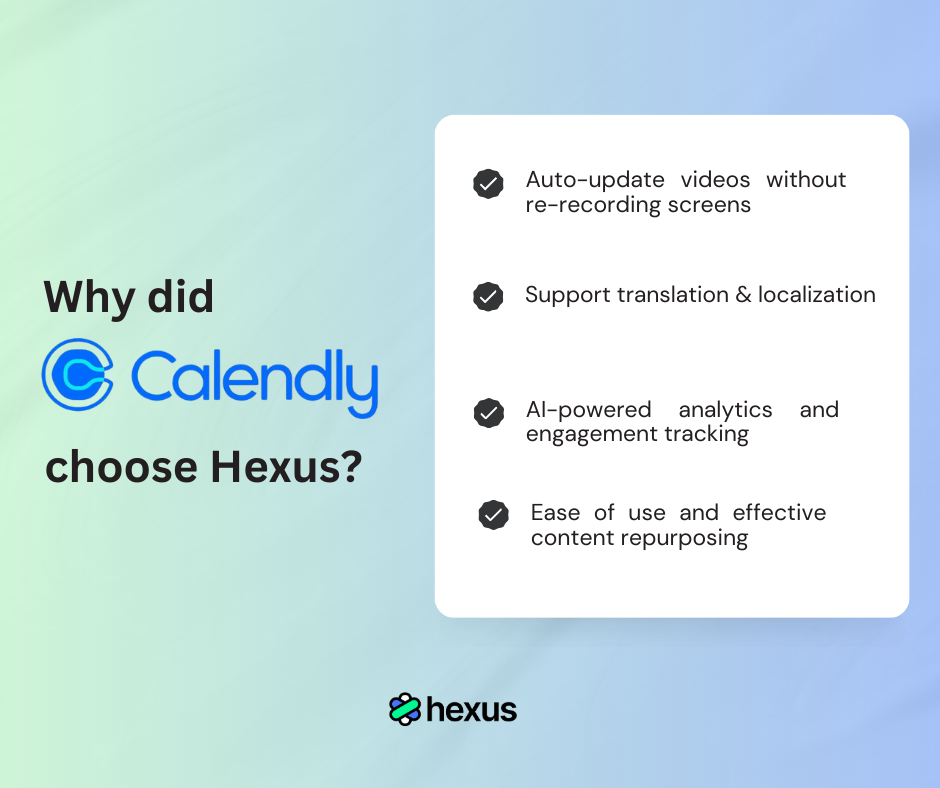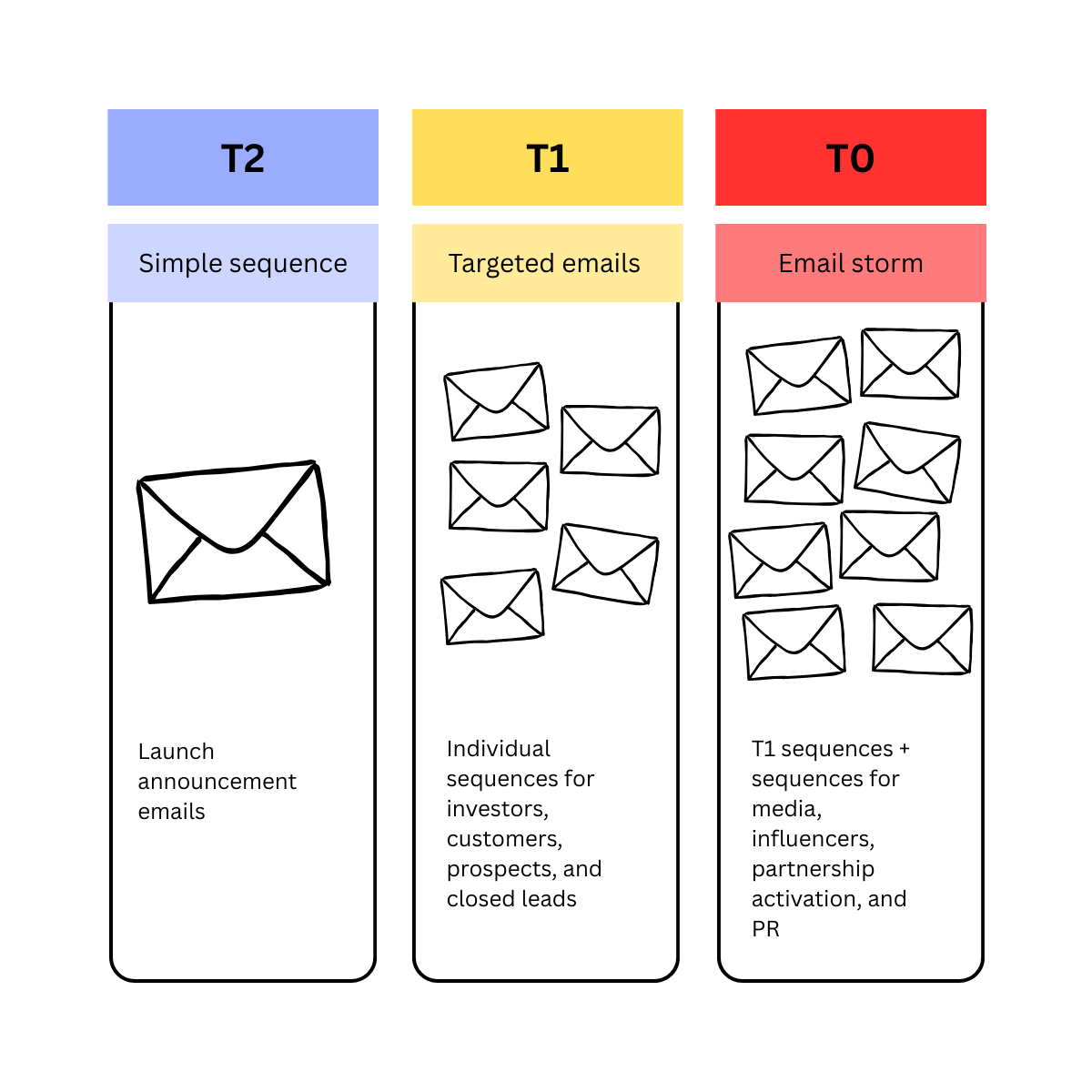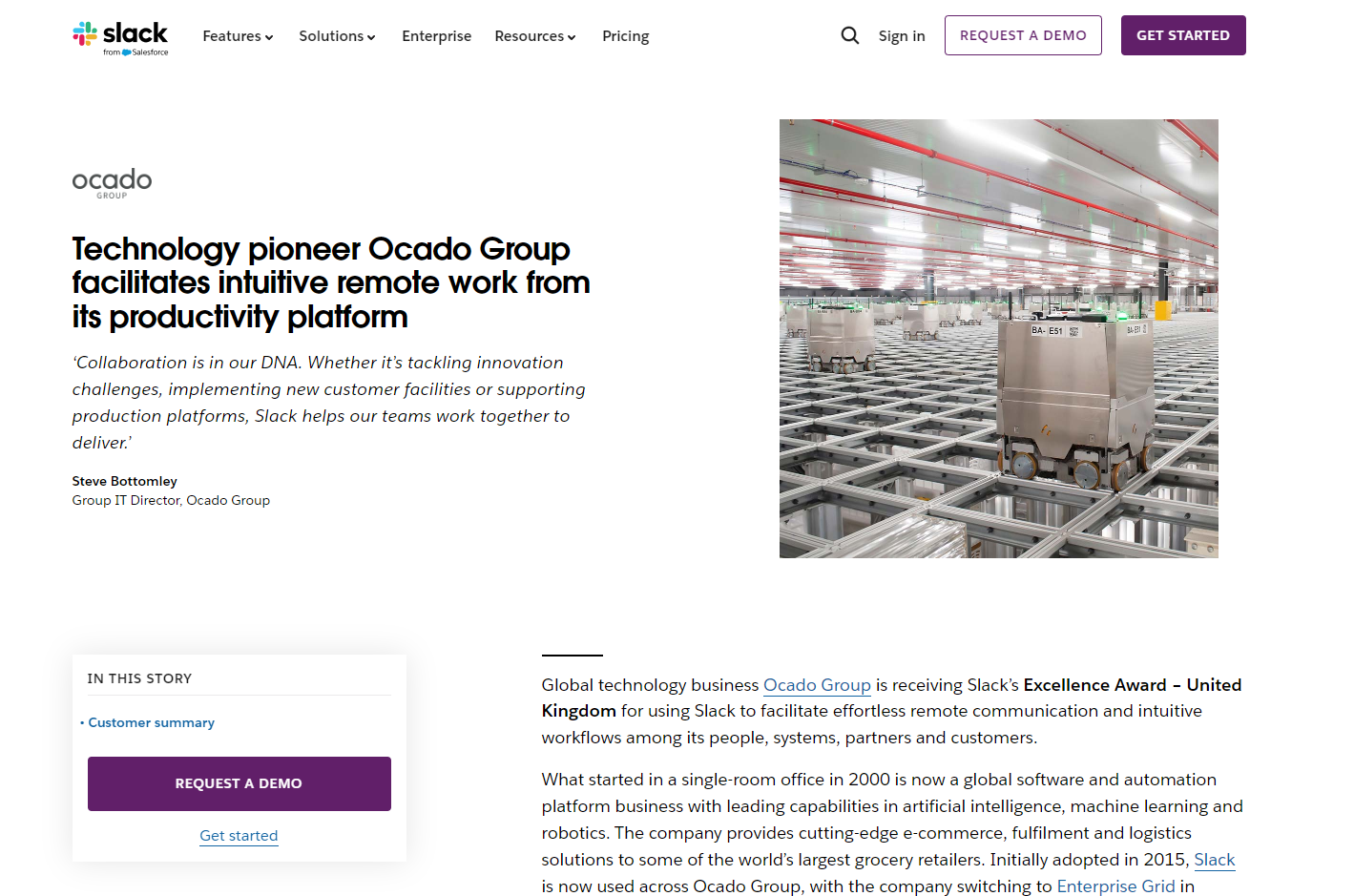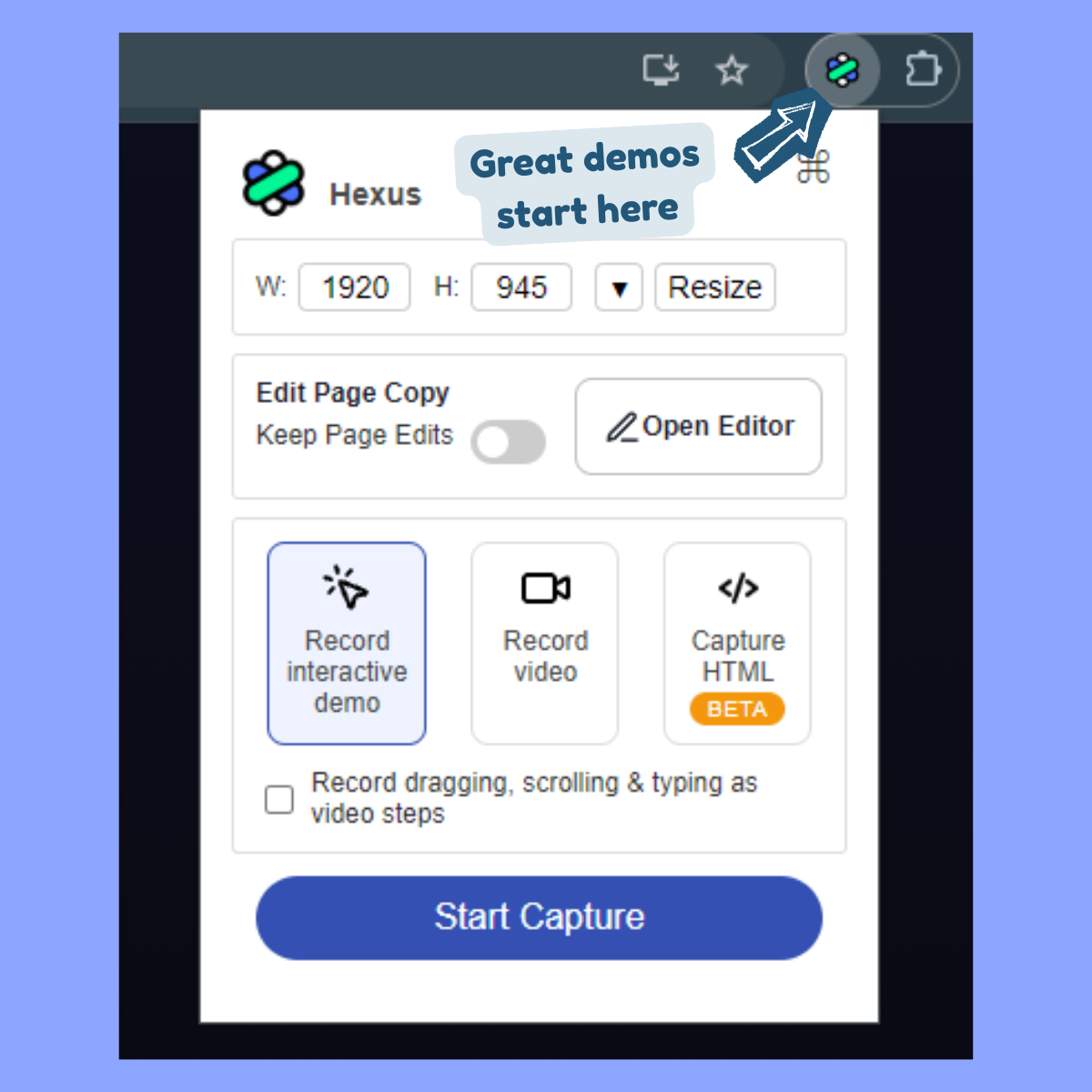How Calendly Transformed It's Content Creation with Hexus
.png)
Calendly needs no introduction. It is one the most widely used tools by professionals looking to streamline scheduling and eliminate the back-and-forth of email coordination. It integrates with popular tools like Google Calendar, Outlook, Zoom, and Salesforce to help users optimize their time and enhance productivity.
Calendly serves millions of businesses globally, helping organizations improve customer interactions, sales processes, and internal team coordination. Some of their key offerings include:
- Automated scheduling to eliminate manual booking conflicts
- Seamless integrations with CRM, conferencing, and email tools
- Enhanced team collaboration with shared and round-robin scheduling
- Customizable workflows for lead qualification and client interactions
What were the key challenges?
Calendly's Help Center team faced significant challenges in maintaining up-to-date, engaging video content for self-service support. Their existing video creation workflow required full re-recordings for any UI or product updates, leading to delays in content accuracy and increased workload for the content team.
Before adopting Hexus, Calendly’s content team struggled with the process of creating and updating video tutorials and demos for their Help Center and Video Library. Additionally, the team sought to enhance their instructional content with media elements that catered to different learning styles, ensuring users could easily find and understand the information they needed without relying solely on text-based documentation.
Lea Gossett, Content Specialist: "Before adopting Hexus, one of the biggest challenges in developing both technical and strategic content was the time-intensive process of updating videos. Previously, any product or UI change required re-recording the entire video from scratch, rather than making targeted edits. This made it difficult to keep our Help Center videos consistently up to date, as the time and effort required to recreate full videos often led to delays in replacing outdated content. Strategically, this limitation impacted our ability to provide users with the most accurate and relevant self-service resources. The longer turnaround time meant that some videos remained outdated for extended periods, potentially causing confusion for users."
Donna Kelly, Senior Manager of Help Center: “One of the biggest challenges encountered in developing technical and strategic content is catering to different learning styles. When it comes to instructional content, it’s difficult to balance customer needs and what is sustainable for content teams with product evolution. This typically results in media either being left out of the equation, or the media included in content is out of date and not detailed enough for customers to rely on when attempting to overcome their obstacles.”
The need for a solution that allowed Calendly to maintain accurate, engaging, and timely video content became clear.
.png)
What were their strategic goals?
Calendly aimed to:
- Build a scalable, efficient process for updating Help Center videos
- Improve user engagement with self-service content
- Provide accessible and visually engaging instructional material
- Ensure content remained up to date with product updates
"Our goal was to create instructional content that not only showed users how to perform actions but also provided context on why and how they could leverage Calendly’s features effectively." — Donna Kelly, Senior Manager of Help Center
Why Hexus?

Calendly adopted Hexus for its advanced AI-powered video editing capabilities, ease of use, and efficient content repurposing tools. The platform stood out due to its ability to:
- Enable slide replacement & editing: Update specific sections of videos without re-recording from scratch, significantly improving content maintenance workflows.
- Support translation & localization: Expand the accessibility of Help Center videos for a global audience.
- Provide analytics & engagement tracking: Monitor user interactions and optimize content strategies based on performance data.
What were the results?
Streamlined video creation and updates
With Hexus, the Calendly team successfully reduced video update turnaround times. Previously, editing or replacing a video required several hours of effort, whereas now, content specialists can update a video within 30 to 60 minutes, depending on the scope of changes.
By incorporating Hexus into their release processes, the team ensured that Help Center videos remained up to date, aligned with product changes, and were ready to support new feature rollouts in a timely manner. Here's an example -
Improved engagement with self-service content
Calendly increased engagement with interactive, localized videos. Their AI-driven tutorials adapt to individual learning patterns. Prospects and customers now spend more time exploring features on their own. These smart videos simplify complex functionality adjusting to preferred languages and skill levels.
Empowering the Help Center team
With a structured and efficient video update process, Calendly’s Help Center team can now focus more on strategic content creation rather than spending excessive time on video re-recordings. The integration of video content with documentation ensures a more holistic learning experience for users.
"Hexus helps us bridge the gap between static documentation and engaging, visual learning. It allows us to update content efficiently while maintaining high-quality instructional resources." — Lea Gossett, Content Specialist at Calendly

Looking Ahead: Hexus & The Future of AI-Driven Content Creation
Calendly continues to expand its use of Hexus to optimize Help Center content, Website, Product marketing and enhance the self-service experience. With AI-driven insights and efficient editing tools, the team aims to scale content production while maintaining accuracy and relevance for users worldwide. Lea and DK are both excited about the transformative potential of AI in the realm of technical content creation. Lea envisions AI-driven tools revolutionizing the way documentation is maintained, making it smarter and more efficient. One of the most significant advancements she anticipates is AI’s ability to proactively identify areas that need updates. For example, when a product feature changes, an AI tool could automatically detect this and notify the team that related Help Center content requires revision. This capability would ensure documentation remains accurate and up-to-date with minimal manual effort.
Beyond identification, Lea sees AI playing a role in automating content changes. AI could streamline workflows by suggesting, and even implementing, necessary updates. This would not only save valuable time but also enhance the consistency of documentation across different platforms and resources.
Furthermore, AI could personalize user interactions with technical content. Features like AI-powered search, chat-based support, and interactive troubleshooting guides could help users find relevant information more quickly and efficiently. This level of personalization would not only improve the overall user experience but also empower customers to resolve issues independently, reducing their reliance on support teams.
Ultimately, AI’s potential to create dynamic, intelligent, and user-centric technical documentation is immense. By automating routine maintenance tasks, AI would free up content teams to focus on high-impact, strategic content creation, driving more value for both the company and its users.
Advice for Customer Enablement teams and driving Product-Led Growth
For those starting out in customer enablement or driving Product Led Growth, Lea offers the following advice:
- Put Yourself in the Customer’s Shoes
Always start by thinking about the user’s perspective. Ask yourself: "If I were looking for this information, what would I need to know? How would I prefer to receive it?" Ensuring that content is clear, accessible, and valuable to the end user should always be the top priority. - Balance Technical Accuracy with Clarity
One of the biggest challenges in content creation is simplifying complex technical information without losing accuracy. Break down concepts into bite-sized, easy-to-understand chunks. Use simple language, incorporate visuals to illustrate key points, and provide actionable steps to guide users toward solving their problems effectively. - Stay Proactive About Updates
As products evolve, documentation can quickly become outdated. Instead of waiting for content to become irrelevant, develop a proactive approach to regularly reviewing and updating resources. Leverage AI or automation tools, when possible, to help identify content that needs revision and ensure that users always have access to the most current information. - Be Adaptable and Open to Feedback
Customer needs are constantly changing, so flexibility is crucial. Great content creators continuously adapt and improve their work based on real-time user feedback. Engage with customer support teams, analyze content performance, and listen to direct feedback from users to fine-tune your resources. - Leverage Tools to Work Smarter
In today’s fast-paced environment, content creators must work efficiently. AI-driven tools like Hexus can help streamline the content creation and maintenance process, allowing you to focus more on strategy and high-impact initiatives. By leveraging these tools, you can ensure your resources remain relevant, engaging, and aligned with your customers' needs.
By keeping the user's experience at the forefront, staying agile, and adopting tools that enhance productivity, content creators will be well-equipped to tackle the challenges of customer enablement and content creation—ultimately driving better outcomes for both the team and the users they serve.
Try Hexus for Your Team
Hexus has proven to be a game-changer for Calendly’s content strategy. If your team faces similar challenges in content creation and maintenance, consider leveraging Hexus to streamline your workflow and enhance your user experience.





.png)

.png)